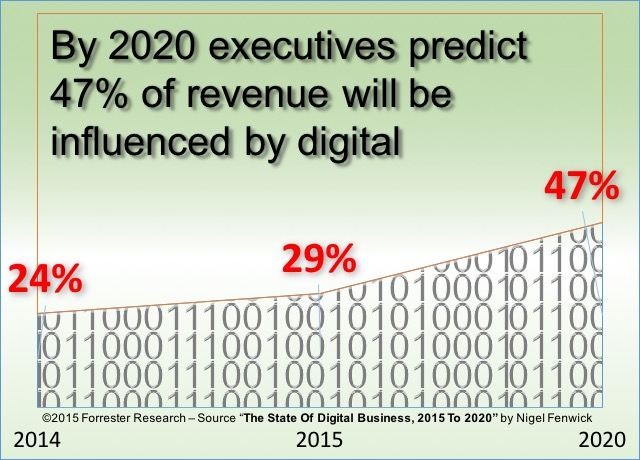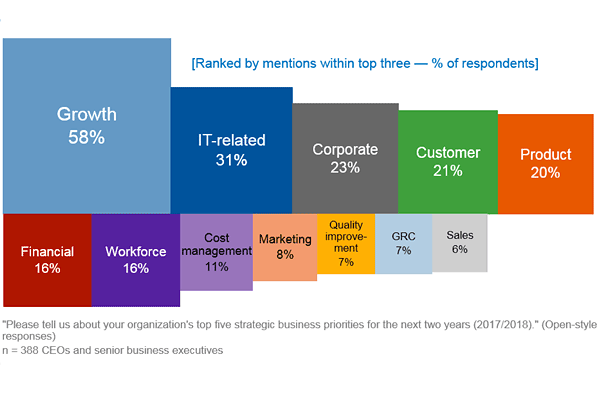Digital Transformation: Why It Matters?

Digital transformation could be in the running for "buzzword of the year." And yet, it's something businesses take very seriously. Here's a primer for 2019.
Author: Brandyn Morelli

Digital Transformation is a hot topic these days. It might be in the running for buzzword of the year, along with blockchain, disruptive, and cloud-native. And yet, it’s a buzzword that businesses are taking very seriously.
As IDG noted in their 2018 State of Digital Transformation Report:
“More than a third of organizations (44%) have already started implementing a digital-first approach to business processes, operations and customer engagement.
Some 19% are in the integration process of making operational and technology changes throughout the enterprise, and 18% are executing their digital plans and making process, operational and technology changes on a department and business unit level.
Just 7% of companies have already fully implemented their digital first approach and are in the maintenance phase.”
A recent Progress report notes that 85% of enterprise decision makers believe that if they don’t make serious progress on digitally transforming their businesses in the next 24 months, they’ll fall behind the competition and take a hit on their bottom line.
Clearly, people believe that digital transformation is a pretty big deal
But despite the significant enthusiasm and high hopes surrounding digital transformation, many people are still fuzzy on exactly what it means and how to implement it.
The whole idea can feel somewhat like Michael Scott’s proposed slogan for Dunder Mifflin in the show The Office: “Limitless Paper In A Paperless World.”
On the surface, it sounds appealing, futuristic, and forward-thinking.
But once people dive into the nitty-gritty of what’s actually involved, things become a little unclear. Phrases such as Internet of Things, asset digitization, and cloud infrastructure get thrown around, often without clarity on exactly how they relate.
The conversation can quickly devolve into buzzword soup.
In this article, we’ll break down the what, why, and how of digital transformation. We’ll walk step-by-step through the exact nature of digital transformation, why it matters to your business, and practical ways to actually implement it.
Consider this a detailed primer on digital transformation— a roadmap if you will.
What is digital transformation?
Essentially, digital transformation is the process of using digital tools and technology to improve or renovate existing processes.
This process involves strengthening or even replacing archaic, slow, tedious, often manual processes, with easier, efficient, and often automated processes.
But we also can apply a broader, more fundamental way to understand digital transformation.
It means integrating digital technology into all departments of a business, which then dramatically changes how each one operates.
Digital transformation also means a change in the business culture. This change starts in the C-Suite and filters down through every level of the business. It involves a commitment to using digital tools to increase the efficiency and, ultimately, the bottom line.
Digital transformation requires commitment because it’s not typically a simple process. It takes significant changes to long-used legacy systems.
This, in turn, means time and resources, as well as buy-in from the employees who will have to learn new ways to do tasks.
David Terrar at Agile Elephant puts it this way:
“Digital transformation is the process of shifting your organisation from a legacy approach to new ways of working and thinking using digital, social, mobile and emerging technologies. It involves a change in leadership, different thinking, the encouragement of innovation and new business models, incorporating digitisation of assets and an increased use of technology to improve the experience of your organisation’s employees, customers, suppliers, partners and stakeholders.”
And while all this may sound great, it does raise the question: why does digital transformation even matter?
Why digital transformation matters for your business
Frankly, all the high-level talk about the matter can fail to answer the fundamental question of why you should even care. After all, if it’s not broke, why bother fixing it? If long-standing processes and workflows seem to be getting the job done, why rock the boat?
These are certainly valid questions. There are a number of costs associated with digital transformation. It requires a significant commitment in order to make it all work. Is it really worth it for your company to invest time, money, and human capital in this process?
Short answer: yes.
At the risk of overstating things, it’s a matter of survival. Maybe not in the immediate future, but certainly a few years down the road.
Four reasons why digital transformation matters
You can think of these as a series of falling dominoes, with each one leading to the next.
1. Increased efficiency
By its very nature, digital transformation involves making processes and workflows faster, easier, and more efficient.
For example instead of spending hours processing paperwork, you can create digital workflows that will seamlessly and automatically move documents to their proper locations.
This increased efficiency frees up employees to focus on other, more revenue-centered activities.
In a recent survey of 100 IT leaders by Vanson Bourne, 44% of respondents indicated that legacy systems hold back or hamper nearly every project.
Digital transformation enables you to create much more efficient systems and processes, which in turn allows key tasks and projects to move forward much faster.
2. Improved customer experience
Implementing digital transformation allows you to remove points of friction experienced by your customers.
For example, if new clients or customers need to fill out a series of onboarding documents, digitizing and automating that process can lift a significant burden from the them.
This leads to higher customer loyalty and a greater Customer Lifetime Value.
3. Increased profits
The statistics are clear that implementing digital transformation leads to improvements on the bottom line.
In a recent Gartner survey, 56% of CEOs said that digital improvements have already led to increases in revenue. With this being the fundamental goal of all businesses, this in and of itself is reason to move toward it.
4. Keeping up with the competition

It follows that if digital transformation leads to increased profits, it’s also necessary for keeping up with your competition, who are most certainly implementing a digital transformation strategy.
A recent Forrester survey shows that executives believe that within five years, as much as 50% of their revenue will be driven by digital changes to their businesses.
Bottom line: Your competition know that digital transformation is crucial for future business success, and if you want to keep up with them, you also need to consider a competitive strategy.
Implementing digital transformation in your business
It’s one thing to recognize its importance, but making digital transformation a reality in your business is a different animal altogether.
It’s the difference between talking about running a marathon and actually doing it. Talking about the health benefits and the sense of pride of completing a goal come naturally. Actually running the race requires an intense commitment to training, eating properly, and purchasing the appropriate running gear.
So how do you move from talking about digital transformation to the actual transformation?
We recommend these ten steps for implementing digital transformation
1. Get the full support of top-level management
As noted earlier, this simply can’t happen if the CEO and leadership team aren’t on board. Making the transformation a reality requires time, human capital, and financial resources. It also involves employees learning to do tasks in new ways, which can generate pushback.
Additionally, because it touches every department, it’s essential that the push come from the top down. This commitment signals to everyone in the company that digital transformation is a priority requiring commitment from all parties.
“…the CEO cannot simply sanction a digital transformation; he or she must communicate a vision of what needs to be achieved, and why, in order to demonstrate that digital is an unquestionable priority, make other leaders accountable, and make it harder to back-track.”
2. Identify strategic change areas
There are certain areas in your business that will benefit most from digital transformation. For example, internal research may show that shortening the time between an application being submitted and company follow up will dramatically increase customer loyalty and reduce the overall churn rate.
Once you’ve identified strategic areas for improvement, look for specific ways digital transformation can contribute to that improvement. Are there ways to automatically move submitted applications to the appropriate individuals? Can the application process itself be made simpler and easier for the customer? By implementing digital transformation in key areas, you maximize the overall effect.
3. Allocate sufficient funding
Almost every change project will require some portion of the budget. Whether it’s replacing legacy systems, making strategic hires, or creating partnerships with other companies, funding will be required.
To state the obvious, it’s critical to determine approximately how much the digital transformation process will cost and then set aside the appropriate resources. It’s true that it won’t be cheap, but the cost of ignoring it will be even greater. Additionally, the benefits created will far outweigh the costs in the long run.
4. Create a launch team
There’s a high probability that neither your executives nor your employees will have experience in engineering digital transformation. If you give them the job of bringing the change to pass, the endeavor will probably fail.
The solution? Creating a team of experts who can lead the process. This usually starts with hiring someone like a Chief Digital Officer, who is then responsible for assembling a team of employees, consultants, and engineers to ensure that everything runs smoothly.
Duncan Tait, Head of Americas and EMEIA at Fujitsu, puts it this way:
“While businesses today recognize the need to adopt and adapt to technology, there remain significant issues that are contributing to substantial rates of failure and high associated costs. To realize their digital vision, it’s crucial that businesses have the right skills, processes, partnerships and technology in place. With digital disruption rapidly changing the business landscape, businesses can’t afford to fail in their transformation.”
5. Start with low-risk projects
This works in conjunction with Step #2. After identifying strategic change areas, start your digital transformation with relatively simple, low-risk projects in the strategic areas. Making small progress on big goals creates a sense of momentum and helps people see the overall potential.
Additionally, tackling smaller projects can give you at least a limited sense of what will be involved in the project as a whole.
6. Carefully introduce new workflows
Digital transformation always involves creating new, more efficient workflows. However, the launch team must be careful as they introduce these workflows within the different departments. If the workflows are simply dumped on a department en masse, it can create chaos and engender resentment.
Additionally, the launch team must be aware of the office politics that often accompany new initiatives. Department executives can be territorial and may push back against anything that seems like it might make things more complicated.
The launch team must carefully (and often slowly) introduce new processes, giving employees and department heads adequate time to process and learn them.
7. Continue to build the culture
Digital transformation isn’t a one-and-done process. Rather, it’s something that must be woven deep into the culture of your business. Technology is evolving at an incredibly rapid pace, and in order to keep up there must be a willingness within the organization to adapt, experiment, and strive for continuous improvement.
If this is seen as simply a one-time project, your company will fall behind competitors as technology continues to evolve. A company culture must be created that recognizes these new realities and is prepared to keep pace with them. “Evolve or die,” may be a cliche by this point, but there remains some truth in it.
8. Build momentum
As you make progress on the strategic areas you chose at the beginning of the process, you’ll begin to pick up momentum. Those areas of your business that have been transformed should generate additional revenue, which can then be used for further digital transformation.
Every new transformation initiative should build on the previous one, ensuring that momentum continues to build and revenue continues to come in.
As your efforts begin to snowball, continue to focus on strategic areas that will continue to enable growth. Don’t begin chasing every possible opportunity. Focus on the 20% that will move the needle.
9. Increase core business capabilities
If things go well during the initial rollout, there will come a time when more substantive changes are needed. Core operating platforms, as well as the people who run them, will need to be boosted in order for further transformation to be possible.
In some ways, this is the tipping point for your company. If you continue to build out your core business capabilities to enable further transformation, you can truly become a leader in your industry.
10. Change your operating model
A full digital transformation will eventually require you to implement a new operating model. Departments and functions that were once siloed will need to be reorganized to enable communication and collaboration. Data that was once the property of a single business entity must be easily shared across the company.
To quote McKinsey & Company again:
“…companies will have to lean away from a traditional matrix structure with rigid functional boundaries if the transformation is to succeed. They will need a network structure, organizing around sources of value, with product managers empowered to make decisions with implications that cut across functions.”
The times are changing
When it comes to the way successful businesses run, the times are certainly changing. The, “If it’s not broke then don’t fix it,” model simply doesn’t work anymore. Technology moves too fast and your competitors are moving with it. It’s not about keeping up, it’s about not falling behind.
Creating a company-wide digital transformation won’t be any by easy means. But it’s a worthwhile necessity. The increased efficiency, customer satisfaction, and revenue set you up for years of success.
Former president Bill Clinton put it this way: “The price of doing the same old thing is far higher than the price of change.”
We wholeheartedly agree.
Brandyn is the Agency Development Director at MojoTech, a custom software development consultancy.
Ref: www.clickz.com

